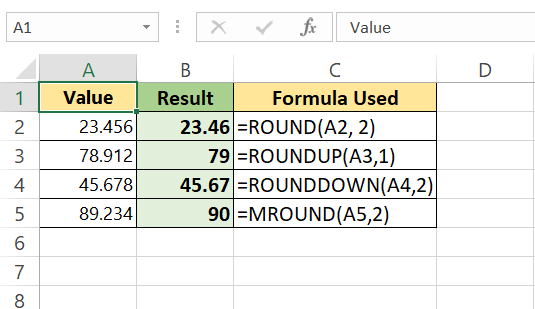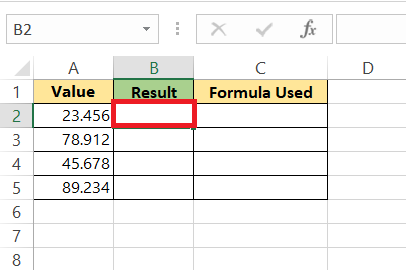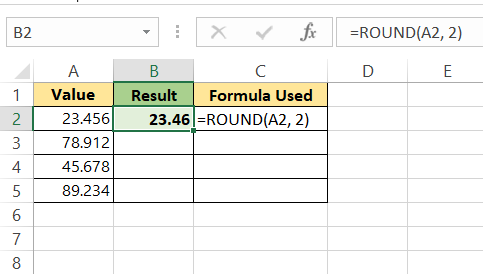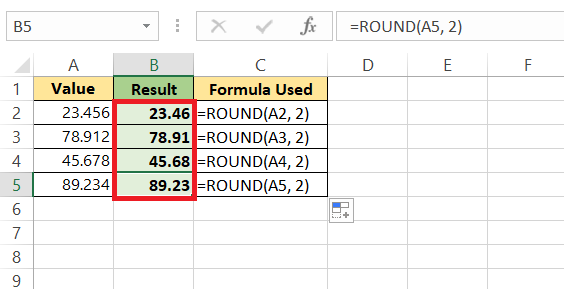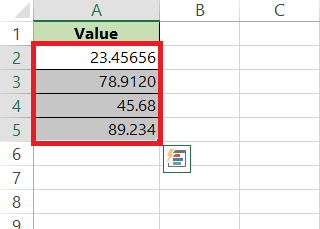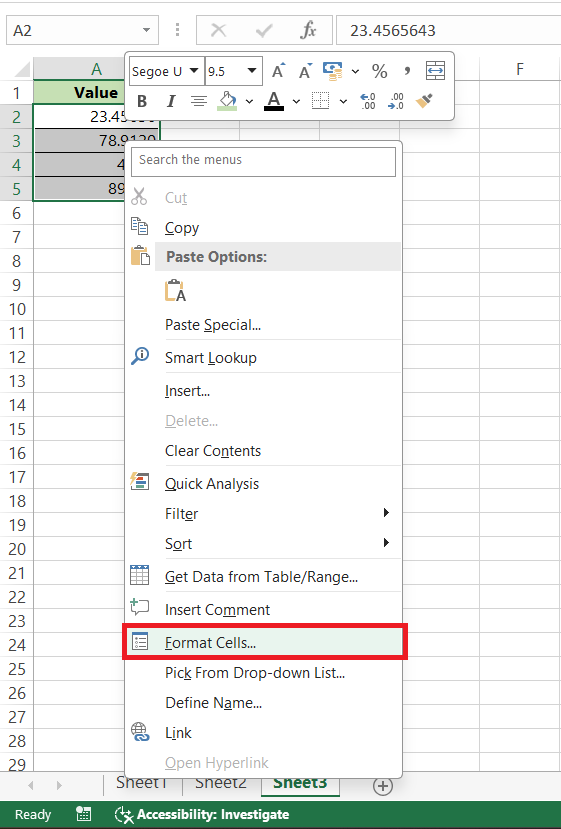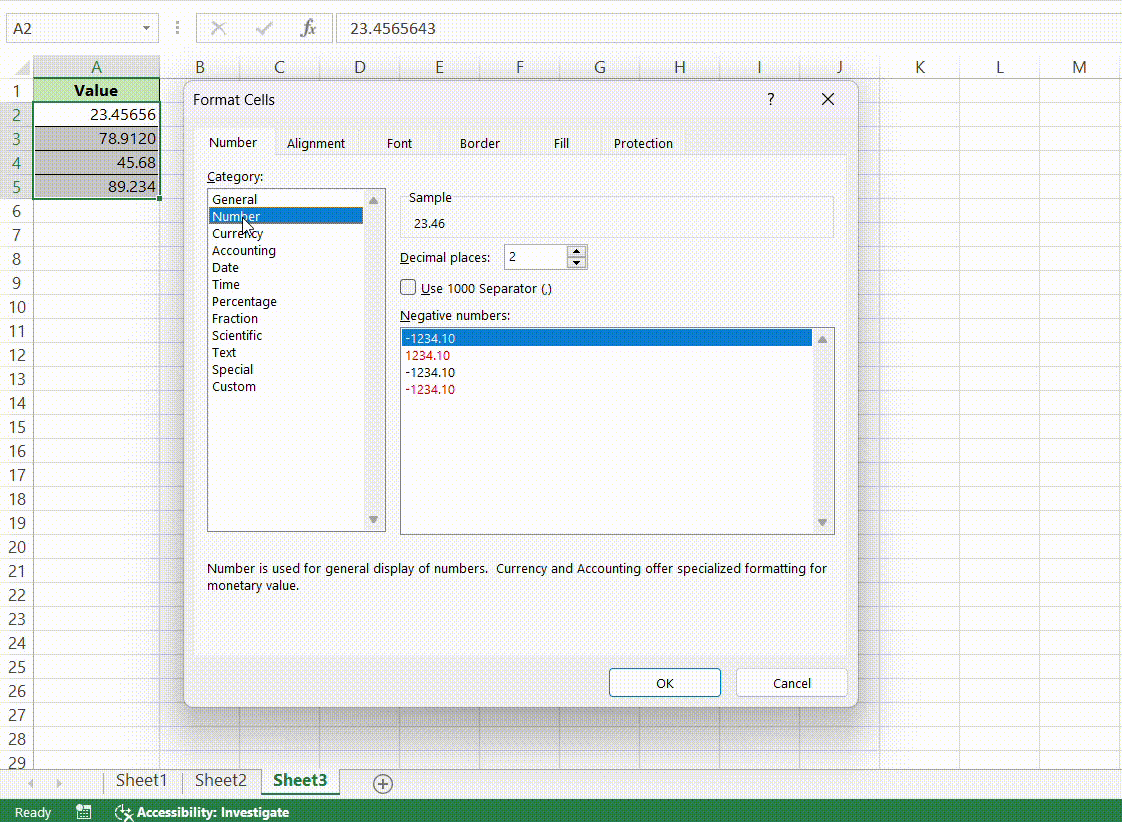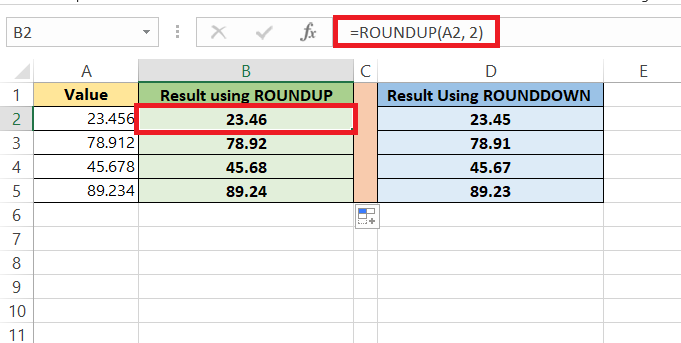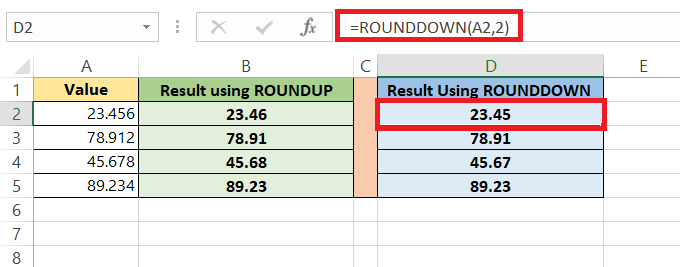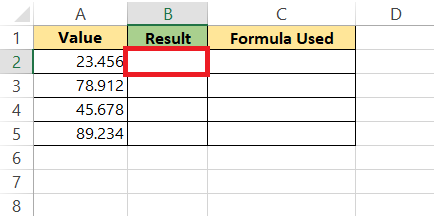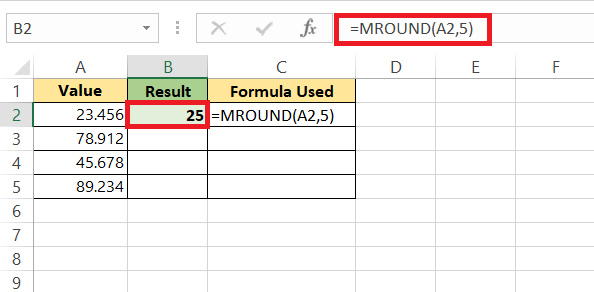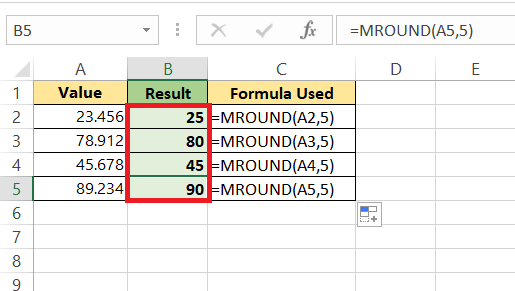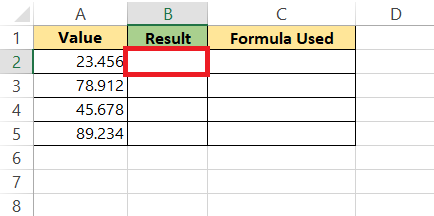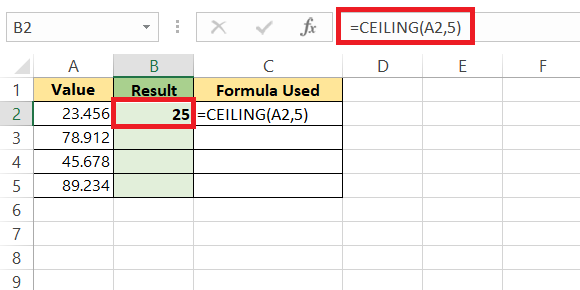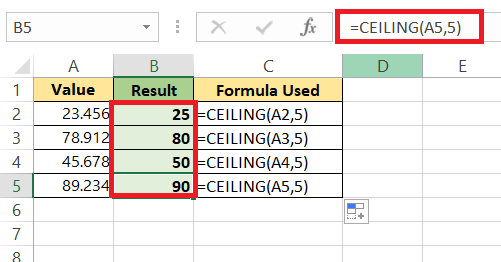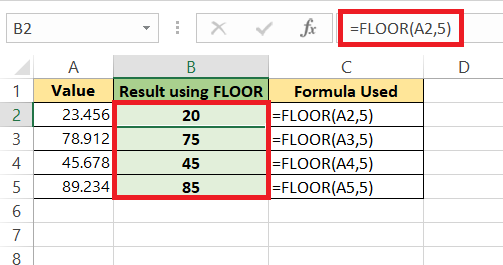Rounding numbers in Microsoft Excel simplifies data analysis, making datasets easier to read and compare. This practice is crucial for clear, confident decision-making. Excel offers various rounding functions, allowing precise control over numerical data. In this article, we will cover the guide on how to round two decimal places in Excel.
Key Takeaways:
- Essential Role: Rounding makes data more digestible and comparable.
- Excel Functions: Use ROUND, ROUNDUP, ROUNDDOWN, MROUND, CEILING, and FLOOR for different rounding needs.
- Practical Use: Rounding to two decimal places is vital in pricing, tax returns, and financial reporting.
- Adjusting Display: Format cells to change the appearance of decimal places without altering actual values.
- Accuracy Tips: Round at the end of calculations and be consistent across datasets to maintain precision.
Table of Contents
Introduction to Number Rounding in Excel
The Essential Role of Rounding in Data Analysis
When you’re diving into data analysis in Excel, rounding numbers can often be your trusty companion. By trimming down the long strings of digits to just two decimal places, the essence of the data stays intact, but it becomes much more digestible and comparable. This act of rounding can mean the difference between a cluttered, confusing dataset and one that allows for clear, confident decision-making.
Overview of Excel’s Rounding Functions
Excel provides an impressive array of functions to manage numerical precision effectively. Each function comes with its unique purpose, ensuring that you have full control over how you manipulate your data points. Whether you need a general rounding function like ROUND, or more specific tools such as ROUNDUP, ROUNDDOWN, MROUND, CEILING, or FLOOR, Excel covers all bases.
These functions go beyond mere aesthetics; they modify the actual value in a cell to match the chosen level of precision, which is crucial for accurate analysis and reporting. Dive in, and you’ll discover just how versatile and powerful Excel’s rounding arsenal is for crafting data to suit your exact needs.
Mastering the ROUND Function
A Step-by-Step Guide to Round Two Decimal Places
To use the ROUND function in Excel effectively, let’s break it down into simple, actionable steps. First, select the cell where you want the rounded number to appear. Next, enter the ROUND function: =ROUND(number, num_digits).
In the ‘number’ spot, you place the cell reference or actual number you wish to round. ‘Num_digits’ is where you indicate how many decimal places you want the number rounded to. For two decimal places, you’d enter the digit 2.
STEP 1: Select the cell where you want the result, e.g., B2.
STEP 2: Enter the formula: =ROUND(A2, 2) then, press Enter to round 23.456 to 23.46.
STEP 3: Drag the fill handle down to apply the formula to other cells.
Practical Scenarios for Rounding to Two Decimal Places
Rounding to two decimal places is a practical necessity in various real-world scenarios. When setting up price lists, it ensures that pricing remains consistent and comprehensible for your customers, nurturing their trust. In preparing tax returns, it’s not just preferable but often required to round figures to two decimal places, helping you steer clear of any legal tiffs with tax authorities.
Moreover, when presenting financial statements, investors and stakeholders can pore over the finer details of your financial health without getting lost in a sea of digits. These are just a few samples from an array of scenarios where exactness to two decimal places cannot be overstated.
For example: – A retail business improved its financial reporting accuracy by consistently rounding prices to two decimal places. This practice enhanced customer trust through clear pricing, ensured compliance in tax returns, and provided stakeholders with precise financial statements, ultimately strengthening financial transparency and decision-making.
Fine-Tuning Your Rounding Technique
Adjusting Decimal Places for Precision
If you’re keen on achieving that pixel-perfect level of precision in your spreadsheets, tweaking the display of decimal places is your go-to move. You do this without altering the cell’s actual value—ideal for visual consistency.
STEP 1: Simply select the cells you want to adjust.
STEP 2: Right-click, choose ‘Format Cells,’
STEP 3: Click on the ‘Number’ tab. Here you can set the desired number of decimal places—2 for your purpose.
This keeps the original number intact behind the scenes while giving your data that clean, rounded appearance on the surface. Keep in mind this method is about presentation, not modification of the value, so it’s perfect when aesthetics are key, but underlying precision is still required.
Tips for Ensuring Accuracy in Financial Calculations
When dealing with financial calculations, accuracy cannot be overlooked. Here’s how you can maintain it effortlessly:
- Round at the End: Maintain the full precision of your calculations and only round off the final figure. This prevents the accumulation of rounding errors across multiple operations.
- Use Excel Functions: Harness the ROUND, ROUNDUP, and ROUNDDOWN functions among others to control rounding and ensure that accuracy is by design, not by chance.
- Be Consistent: Apply the same rounding rules across all related datasets to maintain integrity and comparability in your financial analysis.
- Check and Recheck: Always review your rounding rules within complex formulas to ensure they’re working as intended and not introducing errors.
- Educate Your Team: If you’re part of a larger team, make sure everyone is on the same page regarding the rounding conventions being used to maintain uniformity across the board.
By embedding these tips into your routine, you’re on your way to crisper, error-free financial statements that reflect the true picture of financial performance.
Alternatives to the ROUND Function
Exploring the ROUNDUP and ROUNDDOWN Functions
For those times when you need a bit more finesse in how your numbers round off, the ROUNDUP and ROUNDDOWN functions are lifesavers. ROUNDUP does exactly what it says – it pushes the number away from zero to the next digit based on the specified number of decimal places. If, for example, you’re dealing with interest rates or investment growth forecasts where optimism is key, ROUNDUP will ensure you’re always looking at the bright side.
On the flip side, ROUNDDOWN does the cautious dance – it lowers the number towards zero, trimming the excess without going up to the next number. This can be central in cost estimations and budget allocations where overestimation is the enemy.
Both functions follow a simple syntax: =ROUNDUP(number, num_digits) or =ROUNDDOWN(number, num_digits), where ‘number’ is the number you’re working with and ‘num_digits’ specifies the precision level, the number of decimal places to round to.
ROUNDUP
ROUNDDOWN
When to Use MROUND, CEILING, and FLOOR Functions
Deciding between MROUND, CEILING, and FLOOR functions in Excel depends on the specific rounding goal at hand. MROUND rounds a number to the nearest specified multiple that you choose. For instance, if you’re packaging products and need to calculate supply orders based on a fixed bundle quantity, MROUND is the tool for the job.
Example for MROUND Function:
STEP 1: Select the cell where you want the result, e.g., B2.
STEP 2: Enter the formula: =MROUND(A2, 5). Press Enter to round 23.456 to the nearest multiple of 5, resulting in 25.
STEP 3: Drag the fill handle down to apply the formula to other cells in column B.
CEILING takes your number and rounds it up away from zero to the nearest multiple you specify. It’s perfect when you’re calculating material requirements and you can’t purchase less than a certain amount, like floor tiles—you always round up to ensure full coverage.
Example of CEILING Function:-
STEP 1: Select the cell where you want the result, e.g., B2.
STEP 2: Enter the formula: =CEILING(A2, 5). Press Enter to round 23.456 to the nearest multiple of 5, resulting in 25.
STEP 3: Drag the fill handle down to apply the formula to other cells in column B.
As CEILING’s counterpart, the FLOOR function rounds down towards zero to the specified nearest multiple. This works wonders when dealing with discounts or price breaks at set quantities; you round down to apply the correct discount tier.
Each function is honed for cases where standard rounding just isn’t enough, empowering you to tailor your results meticulously to your project’s criteria.
FAQs
How to get Excel to round to 2 decimal places?
To round numbers to two decimal places in Excel, use the ROUND function. Simply type =ROUND(value, 2) into a cell, replacing ‘value’ with the cell reference or number you want to round. Press Enter and the number will be rounded to two decimal places. For visual simplicity, you can also format the cell to show only two decimal places by right-clicking the cell, selecting ‘Format Cells’, choosing ‘Number’, and setting it to 2 decimal places.
How to do a round figure in Excel?
To create a round figure in Excel, you have a few options. For a basic round figure, use the ROUND function by typing =ROUND(number, num_digits) into a cell, where ‘number’ is the value you want to round and ‘num_digits’ is the number of decimal places. For example, =ROUND(A1, 0) would round the value in cell A1 to the nearest whole number. If you need to always round up or down, use the ROUNDUP or ROUNDDOWN functions respectively.
What is the shortcut for rounding in Excel?
Excel doesn’t have a one-key shortcut for rounding numbers. However, a quick way to round is to start typing =ROUND( into a cell, which prompts you to insert your desired number and specify the decimal places. This isn’t a shortcut in the traditional sense but rather a fast method to access the ROUND function.
How to convert it to nearest hour or closest 5 or 10 minutes?
To round time to the nearest hour in Excel, you can use =MROUND(A1,"1:00") to round a time in cell A1 to the closest hour. To round to the closest 5 or 10 minutes, you’d use the same function but change the “1:00” to “0:05” for 5 minutes, or “0:10” for 10 minutes, like =MROUND(A1,"0:05") or =MROUND(A1,"0:10") respectively. These formulas ensure your time values are neatly rounded to your specified increments.
What Is the Difference Between Rounding Numbers and Formatting Cells for Display?
Rounding numbers in Excel changes the actual data in the cell, as done with the ROUND functions, altering the value used in calculations. On the other hand, formatting cells for display only changes how the number appears on your screen, without modifying the cell’s actual stored value. So, while both may show a similar rounded number visually, only the ROUND function affects the actual data used in computations.
John Michaloudis is a former accountant and finance analyst at General Electric, a Microsoft MVP since 2020, an Amazon #1 bestselling author of 4 Microsoft Excel books and teacher of Microsoft Excel & Office over at his flagship MyExcelOnline Academy Online Course.

